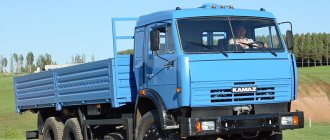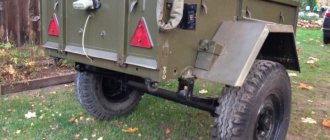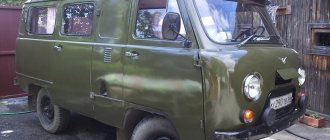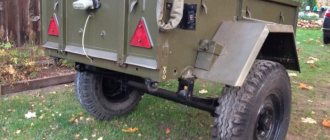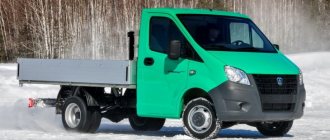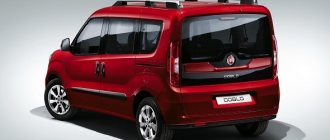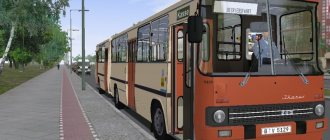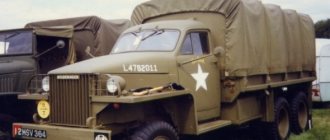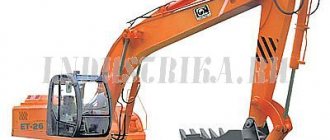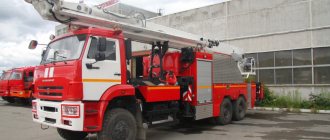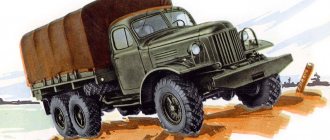The ZIL-157 army truck received more nicknames and nicknames than all other Soviet vehicles. Depending on the location and time, he was called “Cleaver”, “Truman”, “Mormon”, “Zakhar”, “Iron” and a number of other names. Sometimes you can come across the nickname “Polaris”, hinting at the high-speed qualities of the car and the American ballistic missile of the same name of those times.
Due to its off-road characteristics, unpretentious and high-torque engine, the ZIL-157 was used for a long time in the Soviet Army in parallel with the more modern ZIL-131 truck.
History of the car
One of the reasons for the creation of the ZIL-157 cargo truck was the change in the model of the two-axle ZIL-150 truck to the improved ZIL-164. Trucks from the ZIL plant with all-wheel drive and rear-wheel drive were unified in a number of components, so the creation of a new vehicle became an obvious step. The experience of military and civilian operation of the ZIL-151 revealed a number of design flaws that were corrected in the new model.
A number of changes were introduced into the design of the truck aimed at eliminating shortcomings identified during the military operation of previous generation vehicles. In particular, a four-row radiator was introduced, which reduced the thermal regime of the engine and reduced the likelihood of overheating.
When creating the ZIL-157, it was possible to reduce the length of the vehicle and improve weight distribution along the axles, which had a positive effect on cross-country ability.
The first samples of the car were presented at an exhibition in Brussels in 1958, where the truck received the Grand Prix. By the end of the year, the first batches of commercial vehicles began shipping from the plant. Since 1977, parallel production of cars began at the UAMZ plant located in the city of Novouralsk.
The company produced the ZIL-157K variant for about a year, after which it switched to the production of the modernized ZIL-157KD model. Assembly of the ZIL-157KD ended in Moscow in 1982 (separate batches of vehicles were shipped until 1988), and at UAMZ in 1991. The Ural plant assembled individual cars from a backlog of parts until 1994.
Engine
A powerful six-cylinder engine is installed inside the car. It is mounted on an aluminum head. To improve the operation of the cooling system of the power unit and increase performance characteristics, manufacturers replaced the carburetor and modernized the oil pump, which is also installed in the design.
Main characteristics of the ZIL-17 power unit:
- The maximum number of cylinders is 6.
- Volume of labor, liters – 5.
- Power, horsepower – 104.
- Fuel type - gasoline.
- The maximum rpm is 2600.
The K-88AZh unit is used in the form of a carburetor.
Fuel consumption
The ZIL-157 engine consumes less fuel compared to its predecessors. For 100 kilometers, a truck will require up to 40 liters of fuel, which is significantly less if we consider other power units.
Design
Structurally, the ZIL-157 truck was a modified version of the ZIL-151 all-terrain vehicle, taking into account consumer comments.
Main design differences:
- use of tires with one wheel with a directional off-road tread pattern;
- use of rims of reduced radius;
- moving the spare wheel into the gap between the body floor and the frame side members;
- reducing the frame length by 25 cm due to the relocation of the spare wheel;
- introduction of a tire pressure regulation system with manual control from the cab;
- improvement of geometric cross-country ability;
- introduction of an additional tank for 65 liters of gasoline located in the rear part of the frame;
- changing gear ratios in the box;
- improvement of materials and means of protecting transmission units.
The ZIL-157 truck uses a riveted frame equipped with reinforcements in the area where the balance suspension axis is installed. The side parts of the frame are made of stamped spars having a variable cross-section along the length.
Cabin
The ZIL-157 truck was equipped with a three-seater cab with an all-metal structure. Access was through two doors equipped with sliding windows. The cabin featured an adjustable driver's seat and a two-seater sofa. Under the pillow and behind the back of the sofa there are niches for storing tools and equipment. The walls of the salon were lined with cardboard.
The cab of the ZIL-157 truck was equipped with a ventilation and heating system with an electric fan that directed the flow to the windshield. In hot weather, the driver's windshield could be folded down for additional ventilation (on cars manufactured before 12/1971).
Cars in the tropical version did not have a heater radiator and were equipped with an additional fan in the cabin. The windshields were cleaned using a vacuum-driven cleaner against vacuum in the engine intake manifold. The rear window was oval-shaped and equipped with a protective mesh (until 1960).
By separate order, ZIL-157 army trucks were equipped with a cab roof with a hinged hatch.
In the cabins of army vehicles there were regular places to accommodate the weapons of the driver and accompanying person.
Body
Behind the cab of the ZIL-157 truck there is a wooden platform equipped with a reinforcing metal frame. Only the tailgate, equipped with two steps with hinged fastenings, could be tilted. The side boards had attachment points for folding benches, designed to accommodate 16 people. Five arcs could be placed on the sides for installing a canvas awning equipped with ventilation holes.
The side board extensions consisted of six narrow boards; since 1975, their number has been reduced to three.
On cars produced before 1963, the front and rear sides of the body were equipped with yellow and red reflectors, respectively. They were abandoned after the introduction of plastic lenses on lanterns instead of glass ones. Two tool boxes are mounted under the floor of the ZIL-157 platform.
Civilian vehicles produced after 1975 could be equipped with folding side panels. The latest releases of vehicles were equipped with a platform borrowed from the ZIL-131N truck.
Power unit
The ZIL-157 trucks used a 6-cylinder carburetor engine with a liquid cooling system, which was a development of the ZiS-5 truck engine.
With a displacement of 5.555 liters and a compression ratio of 6.2, the engine developed 104 hp.
Export cars could be equipped with a 107-horsepower engine, which was equipped with a modified carburetor, a cylinder head with a compression ratio of 6.5 and was intended for use with A70 gasoline.
After modernization in 1978, which consisted of unifying a number of components with a ZIL-130 engine, the engine output increased to 110 hp. The use of pistons from the ZIL-130 truck engine reduced the cylinder displacement to 5.38 liters. The low compression ratio of 6.5 units allowed the use of A72 or A76 gasoline.
Transmission
The ZIL-157 truck was equipped with a transmission consisting of a number of components:
- Dry-type double-disc clutch, driven by a lever from a pedal in the cabin. Starting in 1961, the clutch began to be equipped with one disc, borrowed from the ZIL-130.
- Five-speed transmission with an accelerating fifth speed. The first gear did not have a synchronizer.
- A two-speed gearbox for distributing torque across the axles, with both gears reducing the shaft speed.
- A propeller shaft installed between the main and transfer case.
- Three shafts with cardan joints for driving axle gearboxes.
- Since the bridges do not have a pass-through design, an intermediate shaft is placed between the second and third bridges.
The drive of the ZIL-157 front steering axle could be turned off. There is no center differential on the truck. The brake mechanisms of all wheels are drum type, powered by a pneumatic system. The source of pressure is a 2-cylinder compressor driven by the engine crankshaft.
Early series vehicles used a disc parking brake mounted on a shaft between the main and transfer cases. Cars produced after 1961 were equipped with a drum parking brake.
At the request of the customer, a power take-off box was mounted on the main box of the ZIL-157 truck, which was used to drive additional components. Early versions of the boxes had 1, 2 or three speeds, which were switched by a lever from the cab. The PTO setting points differed depending on the number of gears.
When installing the winch, a three-speed gearbox with reverse capability was used.
After the modernization of the main gearbox in 1961, a single-speed reversible PTO was used.
Dimensions
The overall dimensions, reduced in comparison with the 151st model vehicles, made it possible to place ZIL-157 trucks in pairs on standard railway platforms.
Main dimensions of the all-terrain vehicle:
- length – 6.684 m;
- height – 2,360 m (side);
- width – 2.315 m;
- base – 4.225 m (distance from the front axle to the balancer axis).
Chassis
The front axle is mounted on leaf springs, with the ends sealed in rubber cushions. The springs of machines with a winch are increased by 2 pcs. number of sheets. On early ZIL-157 trucks, the suspension used lever shock absorbers, which later replaced units with a telescopic design. The steering was not equipped with a hydraulic booster.
In 1958, search work was carried out to install an amplifier from the ZIL-130, which ended in failure. The use of the amplifier caused overloads of the front axle, which led to breakage of the springs and beams.
The rear axles of the ZIL-157 truck are equipped with a balancer suspension, supplemented by six reaction rods.
The springs are mounted on the balancer axis on plain bearings that can withstand heavy loads.
Transmission
When considering the technical characteristics of the ZIL-157, special attention should be paid to a rather complex manual transmission with five driveshafts:
- one intermediate;
- one each for the front and middle axles;
- two for the rear axle.
Initially, the van was equipped with a five-speed gearbox, in which the fifth gear was an overdrive. However, three years later, the designers abandoned this manual transmission and decided to install a time-tested transfer case, which was equipped with the predecessor of the ZIS-151. It was slightly modified and received better gears and seals. The transfer case is designed according to a two-shaft design.
Specifications
| ZIL-151A | ZIL-157K | ZIL-131N | |
| Curb weight, kg | 5880 | 5540 | 6375 |
| Front axle load, kg | — | 2400 | — |
| Load on rear bogie axles, kg | — | 3140 | — |
| Ground clearance, mm | 260 | 310 | 330 |
| Maximum speed, km/h | 55 | 65 | 80 |
| Fuel consumption, l/100 km | 46 | 42 | 40 |
| Load capacity on the highway, k | 4500 | 4500 | 5000 |
| Load capacity on the ground, kg | 2500 | 2500 | 3750 |
Application
In total, almost 800 thousand ZIL-157 trucks were assembled, which were supplied to the army and civil service. Civilian 157s were used to transport goods and people in areas with poor roads or off-road conditions. At the base of the vehicle there were tanks, fire engines, and mobile workshops.
Army ZIL-157s were used to transport personnel and weapons. The chassis was used for mounting multiple rocket launchers, and also as a truck tractor for missile launchers of the S-75 Desna anti-aircraft complex.
The engineering troops were equipped with drilling rigs based on a truck chassis, which were used to drill water wells to a depth of 15 m.
Sapper units used ZIL-157 truck tractors to deliver PPS pontoon parks. A complete set of components made it possible to build a crossing up to 790 m long and with a carrying capacity of up to 100 tons. One set was transported on 480 vehicles.
Based on the ZIL-157 truck tractors, work was carried out to create road trains with drive to the wheels of a semi-trailer. The army tested a small-scale ZIL-157KV-1 tractor, which worked in tandem with a two-axle active semi-trailer model PAU-3. The bundle was used to transport the 9T22 transport vehicle, which was part of the 2K12 “Cube” tracked anti-aircraft missile system.
The transport vehicle was intended to transport six 3M9 missiles located on supports or in thermally insulated containers.
Benefits of purchasing a truck
The truck is characterized by an all-wheel drive system, and there is also a single-pitch tire. All this significantly increases the overall cross-country ability of the model. For this reason, the vehicle has been used for military purposes for a long time, and now it helps solve a large number of domestic, construction and industrial problems. Despite the fact that the production of the models has ended, the model has not become a thing of the past. The vehicle is widely used in many regions of the country. Many people appreciate the truck’s optimal ability to conquer difficult terrain.
There are not many offers to purchase a car, but if you find them, you can buy a truck at a low price. ZIS models from the 1980s are sold at prices ranging from 50 to 80 thousand rubles. Models of later years of production of an onboard dump truck can be purchased at a price of 120 to 150 thousand rubles.
Modifications
During the production of the vehicle, it went through several modernization cycles, after which the base chassis index changed:
- Basic model ZIL-157, which was produced from 1958 to 1961;
- The first modernization led to a change in the index to ZIL-157K; the vehicle was produced from 1961 to 1978;
- The second modernization of the ZIL-157KD, production lasted from 1978 to 1994.
In addition to the main flatbed truck, a truck tractor was produced with the designation ZiL-157V/157KV/157KDV, respectively. Truck tractors were equipped with two fuel tanks and a coupling device mounted on the frame through wooden beams. Spare wheels were installed behind the cab; a similar arrangement was used on the ZIL-151.
The tractor was equipped with two spare tires - one for the car and the second for the semi-trailer. The towing device on the rear of the frame was missing. The exhaust system used a muffler with a shortened pipe located under the frame. For trucks, the exhaust pipe is located on the left under the floor of the platform, between the axles of the rear bogie. Truck tractors were equipped with generators with power increased to 350 W.
On separate orders, machines were produced in a tropical version, equipped with standard and shielded electrical equipment. A distinctive feature of the ZIL-157 tropical trucks is a copper radiator with improved heat transfer, as well as an additional condensation tank in the cooling system. The thermostat was not installed, nor were the blinds in front of the radiator.
For the installation of special equipment and vans, the plant supplied chassis under the designation ZIL-157E.
The chassis was distinguished by the installation of two fuel tanks with a capacity of 150 liters of fuel each on the sides of the side members and the absence of a spare wheel mounting point.
The spare tire was included in the delivery and was installed in place by the superstructure manufacturer. A towing hook with a lock and spring protective buffers were installed on the rear cross member. According to individual orders, the chassis was equipped with electrical equipment with protection against radio interference and was designated 157EG.
For a short time (1989-1992), the ZIL-MMZ-4510 dump truck with a load capacity of 3000 kg was produced. Production was carried out at the Mytishchi Machine-Building Plant using a dump mechanism borrowed from the 4505 model.
Operator's cabin
The cabin of the ZIL 157 has received many improvements in recent years, which provide high levels of comfort for the driver. Ease of use is based on the presence of improved shock absorbers, which add smooth movement of the car. The engineers did not forget to ensure high levels of comfort during normal movement on snow. The ZIL 157 cabin has a built-in water-powered radiator with a special electric motor. This device helps maintain optimal temperature conditions, even in cold weather.
The driver's seat is comfortable and can be adjusted. In all modern models, the cabin is an all-metal structure; it can easily accommodate both the driver and two passengers. There is a round hatch built into the roof.
Pros and cons of the car
The ZIL-157 truck is valued by its owners for its stability and high cross-country ability even without reducing tire pressure. Short overhangs make it easier to overcome uneven surfaces, and the standard winch has a long cable and easily pulls out a stuck car.
However, due to the specifics of the transmission and outdated engine, the ZIL-157 truck consumes a lot of fuel. The standard gasoline engine is often replaced with Minsk diesel engines D-245. The downside is the lack of hydraulic booster, which makes maneuvering on site a difficult task. When driving on uneven roads, the steering wheel spokes can knock out your thumbs.
Reviews
The vast majority of motorists who have ever driven this truck speak positively about it. First of all, car enthusiasts note the incredible cross-country ability and stability of the van, which copes with enormous loads in extremely unfavorable weather and road conditions.
Motorists are also unanimous in their opinion, noting the truck’s shortcomings. The main disadvantage can rightfully be considered the lack of power steering. To drive a car off-road, you must have great physical strength and endurance. Not everyone could withstand daily flights behind the wheel of a ZIL-157, since after a long trip all the joints and back of an unprepared person began to ache.
Interesting Facts
In 1984, a single prototype ZIL-157KDM was produced, equipped with a cabin and platform from the ZIL-131. From time to time, ZIL-157 trucks without mileage appear on sale, which were stored in army warehouses.
The Jiefang CA-30 army truck, which is a copy of the ZIL-157, is produced in China.
The car is distinguished by front fenders in the ZIL-131 style and a radiator grille similar to the ZIL-150.
ZIL-157 became the first Soviet car with a centralized tire inflation system. Tires created for the truck were used on other army vehicles. Attempts to improve the 157 family of vehicles led to the development of improved transmissions and control systems for all-wheel drive trucks.
Modern Russian army vehicles were created taking into account the operating experience of previous generations of vehicles, including the ZIL-157.
First production trucks are very rare. Surviving cars are purchased as collector's items for subsequent restoration. The more common ZIL-157KD trucks, due to their technical characteristics, are used in areas with poor road conditions for their intended purpose - for transporting goods.
ZIL-157 photo
Read further:
UAZ - unique SUVs with a legendary history
KAMAZ - cars of the era
Mini history
Jaguar XK120
Skoda 422 from the 30s
Buick history
